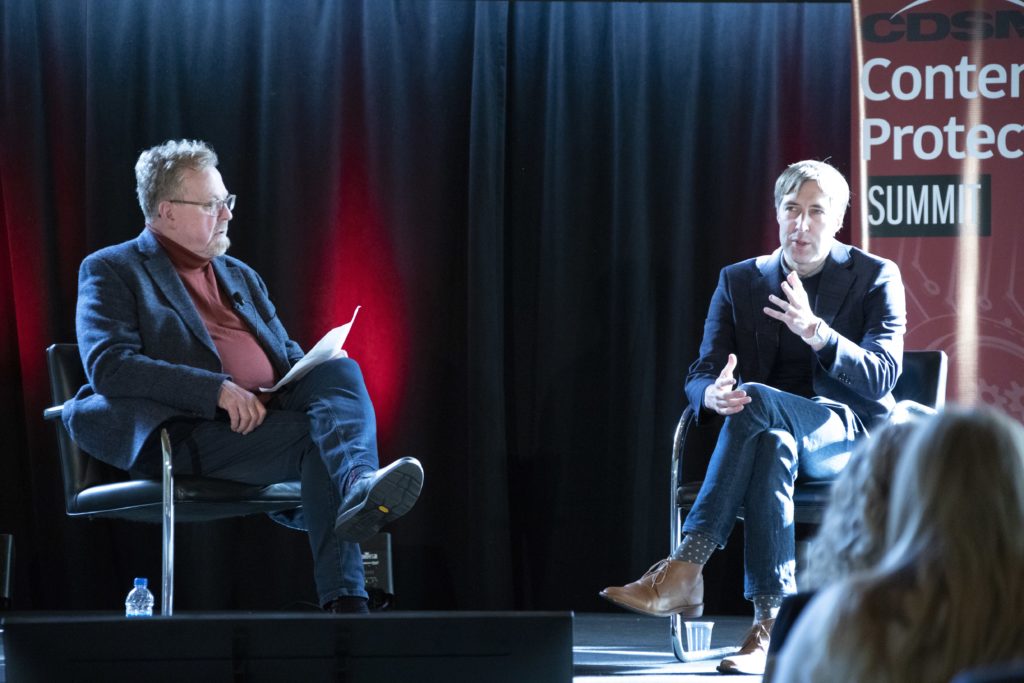
CPS 2022 Keynote: Execs Give Their Takes on the Evolution of the M&E Sector and Security
Edge computing that brings computation and data storage closer to the sources of data provides a solution to certain challenges that the media and entertainment (M&E) sector continues to face, Simon Crownshaw, worldwide strategy director of M&E at Microsoft, said Dec. 6, during the keynote “Perspective from Leadership” at the Content Delivery & Security Association (CDSA) Content Protection Summit (CPS).
Crownshaw was interviewed by Allan McLennan, founder, chief executive and global market technologist at Padem Media Group.
Their conversation was a follow-up to a discussion they had at IBC and dug deeper, providing their leadership perspectives on the evolution of the M&E industry and related security issues that transcend technology.
One of today’s challenges is being able to do “more with less,” McLennan pointed out while asking for Crownshaw’s take.
“It’s almost like you’ve spoken to my boss: Do more with less,” Crownshaw replied. “Many of you can probably relate. I think especially in today’s economic climate, [for] the customers and the partners that we work with,” the video that McLennan showed to start the session “demonstrates the ability and the importance of the cloud,” according to Crownshaw.
 “I think obviously that’s not lost on many people here, even from other cloud providers,” Crownshaw said. “Doing more at the edge, I think, is where we’re trying to resolve latency challenges.”
“I think obviously that’s not lost on many people here, even from other cloud providers,” Crownshaw said. “Doing more at the edge, I think, is where we’re trying to resolve latency challenges.”
But he added: “I think trying to make sure that we can bring those experiences together using the technology of the cloud, there’s a whole host of challenges” that remain.
“From a Microsoft standpoint, we’re trying really hard to take a look at media and entertainment [and] all other verticals in terms of how they’re trying to use that same technology. But the video around the metaverse is just one example,” according to Crownshaw.
But when it comes to “customers today, whether it’s technical challenges, resource challenges – a lot of what we see [are] technical solutions that are there but there are no people there to solve them, or they don’t have a team big enough to do what” needs to be done, said Crownshaw.
Noting that he started working for Microsoft about two years ago after spending “the better part of almost 20 years working at a studio,” he told attendees: “When I went to Microsoft, I was blown away by the power that it has and the connections and the people that I could meet that I would never be able to get” access to while at a studio. “It just opened doors I could never have” opened before, he noted.
“Obviously, we want to focus on the low hanging fruit, the things that we can do, and I think the things that are in our control, I think, from a content creation perspective,” he went on to say.
But he said: “The reality is a lot of other people … control the processes that we’re part of…. So from an easy perspective, I think there’s things from a studio landscape, a broadcasting landscape that we can do [to] migrate very simple workloads to the cloud.”
But the amount of workloads that have been moved to the cloud in the M&E sector is just “a very small percentage compared to other industries,” he said.
Part of the reason for that is resources, while “part of that [are] the technical capabilities that those organizations don’t have.”
Microsoft, meanwhile, “spends billions of dollars every year on cloud security” and “we do work with some of the organizations here and a lot of the studios and broadcasting around the world in terms of protecting their content,” he pointed out.
“Most of the threats around security from a studio perspective are mostly” come from content creation [due to] all the different files that are moving around’ all the time, he said.
 Crownshaw is “seeing probably at least daily threats on the Microsoft side where customers are being held hostage for their content,” he noted. “It’s become such an issue that we are now seeing customers have … as part of their bottom line where they’re going to pay people off just to get their content back. And that is something that we’re seeing.”
Crownshaw is “seeing probably at least daily threats on the Microsoft side where customers are being held hostage for their content,” he noted. “It’s become such an issue that we are now seeing customers have … as part of their bottom line where they’re going to pay people off just to get their content back. And that is something that we’re seeing.”
“But it’s a double-edged sword because … most of what we see, what we hear is security can be a bit of an afterthought” for many companies in the sector, he said. There’s been mostly a “reactive, not proactive [response] in terms of where those threats are coming from, and Microsoft is doing the best they can,” he added.
“Oftentimes we’re finding that customers are finding that our cloud and other clouds are more secure but that security only goes so far,” he conceded. That security, however, “only goes so far depending on the people in the room who are configuring it,” he warned.
“A lot of the studios we work with don’t have the people who understand how [to] architect” security solutions and “rely on third-party vendors or providers to come and help them and that’s where those back doors get left open,” he added.
There is also a cost issue involved for many companies, he noted.
To view the entire session, click here.
Presented by Fortinet and produced by MESA, CDSA’s Content Protection Summit is sponsored by Convergent Risks, Richey May Technology Solutions, GeoComply, Signiant, Verimatrix, Shift Media, EIDR and EZDRM.
